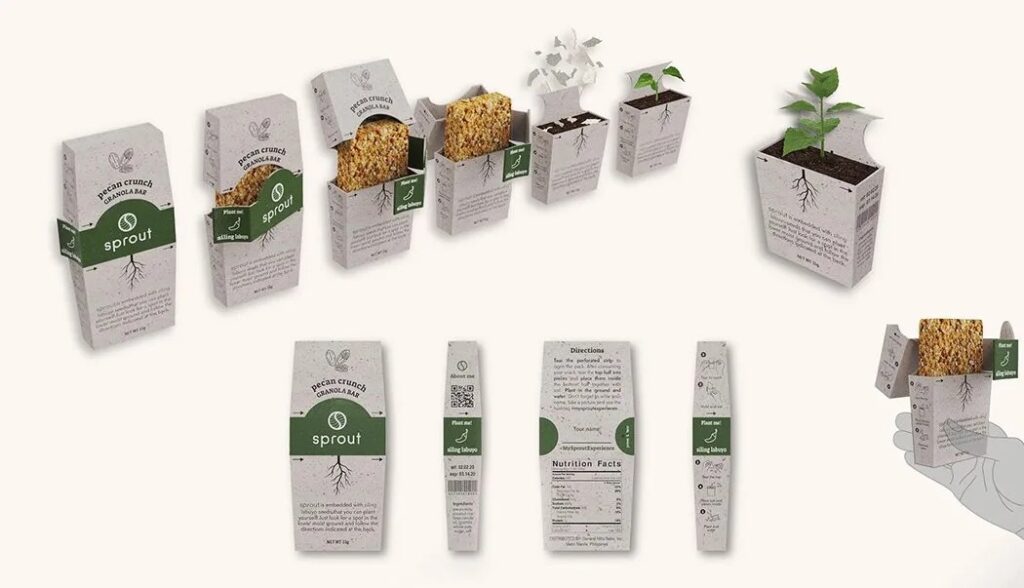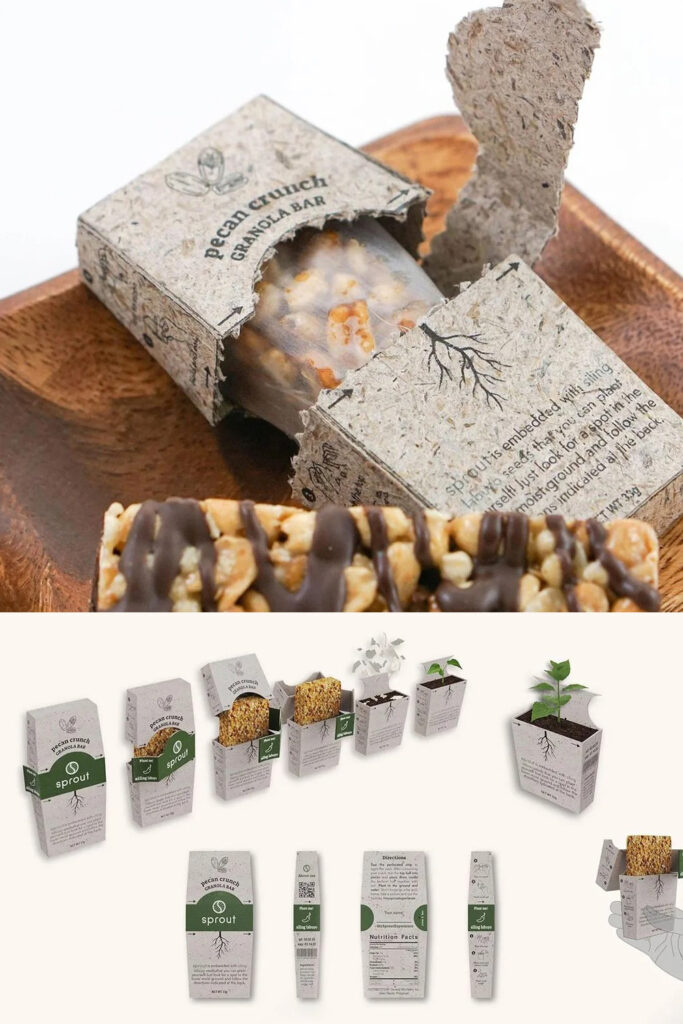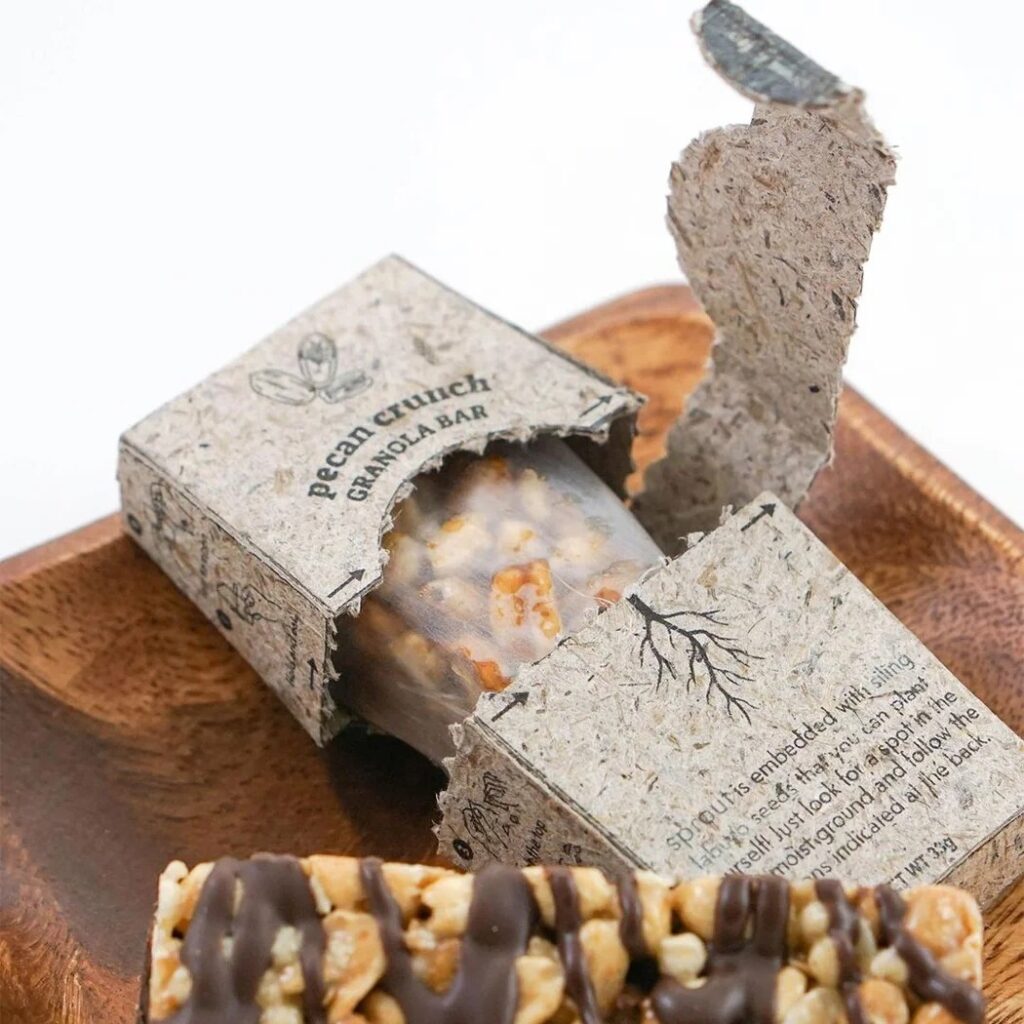Have you ever wondered what happens to packaging after use?
What if, instead of ending up as litter, it sprouts life? 🌱

🌱 Can Packaging Be Planted Instead of Thrown Away?
Each year, over 300 million tons of plastic waste are produced—and nearly half comes from packaging. But what if packaging didn’t just end in the trash? What if it had a second life—in the soil?
That’s the visionary idea behind Sprout Packaging, a groundbreaking project that fuses nature and design into one energy-efficient, circular product. Developed using Pinyapel™—a specialty material made from recycled pineapple leaves—Sprout doesn’t just protect food. It transforms into a seedbed once discarded, reducing carbon footprint and enriching the environment.
 Rethinking Raw Materials: The Power of Pinyapel™
Rethinking Raw Materials: The Power of Pinyapel™
Pinyapel™ combines “Pinya” (pineapple) and “Papel” (paper), signifying both its natural origin and paper-like quality. Instead of using tree-based pulp, Sprout’s raw materials are derived from agricultural waste—specifically pineapple leaves that would otherwise go unused. This turns agricultural waste into high-value, environmentally friendly packaging.
According to the Design Center of the Philippines, Pinyapel™ is water-resistant, food-safe, biodegradable, and recyclable, offering a cost-effective and eco-friendly alternative to traditional paperboard.
🌿 What Is Pinyapel™ & Why It Matters
Pinyapel™, coined from Pinya (pineapple) and papel (paper), is a 100% tree-free paper derived from discarded pineapple leaves—addressing both agricultural waste and deforestation. Developed in the Philippines by the Design Center, it’s water-resistant and compostable, ideal for food-safe packaging

📦 How To Works: From Package to Plant
What sets Sprout apart is its holistic design strategy that considers every stage of the product life cycle:
Manufacturing process: Sprout uses low-energy techniques that require minimal water and chemicals, supporting renewable energy goals.
Design production: The packaging integrates soy-based inks, compostable adhesives, and biodegradable wrappers made from rice or cornstarch.
End-of-life: Once used, the packaging can be planted. Embedded with non-invasive herb or vegetable seeds, it literally turns into a plant—leaving behind no waste.
This isn’t just packaging—it’s a sustainable building block for a circular economy.
.

🌱 Beyond Packaging: Supporting Communities
Pinyapel™’s creation bridges environmental stewardship and economic uplift. It brings value to pineapple farmers by upcycling leaf scraps and has received global recognition, like the D&AD Future Impact Wood Pencil Award
Platforms like Yanko Design have praised Sprout’s circular approach:
“Sprout’s plantable feature ensures that its life does not end right after consumption; its purpose continuously changes…”
⚙️ Sustainable Supply Chains & Business Models
Sprout’s approach goes beyond the product—it represents a shift in the business model. Traditional packaging often ignores environmental cost. But Sprout’s supply chains are designed for sustainability, supporting local farmers and reducing dependence on virgin materials.
By integrating recycled material into its process, Sprout lowers the strain on natural resources while supporting local labor. This decentralized, long-term strategy also reduces emissions from transport and promotes carbon footprint reduction across the supply chain.
🔍 Design Strategies with Lasting Impact
Sprout exemplifies modern design strategies that do more than look good—they work smart:
Circularity: Eliminates waste and reuses resources
Behavioral impact: Encourages responsible disposal habits
Energy efficient: Uses renewable inputs at all stages
Cost effective: Reduces long-term environmental and financial costs
Eco friendly: Materials are biodegradable and compostable
Long term: Adds value beyond its first use
These strategies reflect the future of products and services where each component considers not only its use, but its afterlife.
🧠 Why This Is a Smart Circular Strategy
Circular design: Continuously repurposes materials rather than following a linear “use-discard” model.
Material science: Leverages bioplastic alternatives and agro-waste—key pillars of sustainable innovation.
Consumer psychology: Interactive products forge stronger emotional connections and brand advocacy.


🎯 Environmentally friendly packaging' s Takeaway for Designers & Brands
Eco Friendly Packaging isn’t just clever—it’s a blueprint for sustainable design:
Embed multi-phase utility—materials that serve before, during, and after use.
Leverage local waste streams to create materials that are both eco-conscious and economically viable.
Foster consumer participation by making them active contributors to the product lifecycle.
Eco Packaging invites us to rethink waste—not as the end of a material’s life, but as a beginning. By marrying thoughtful design with sustainable practice, it teaches that packaging can grow—literally and figuratively.
Researchers and innovators are discovering more and more eco-friendly materials—like tea grounds, bagasse, and coffee grounds—in addition to pineapple leaves. To learn more, please check out.
Let me know if you’d like to expand this into a longer case study or include visuals!
You don't know how to start customizing?
Check Here



We Love to Hear From You
You can write down your detailed requirements in the message, for example, style, material, size, quantity, printing requirements, etc. You can also leave accurate contact information, we will contact you within 24 hours!
Leave A Message

